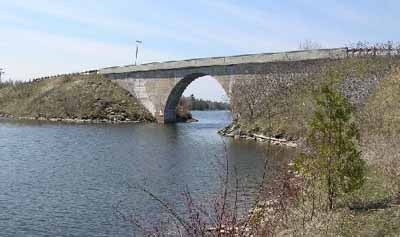Canal Lake Concrete Arch Bridge National Historic Site of Canada
Bolsover, Ontario

General view
© Parks Canada/Parcs Canada 2005
Address :
Centennial Park Road, southwest side of TSW bridge, Bolsover, Ontario
Recognition Statute:
Historic Sites and Monuments Act (R.S.C., 1985, c. H-4)
Designation Date:
1988-06-24
Dates:
-
1905 to 1905
(Construction)
Event, Person, Organization:
-
Department of Railways and Canals
(Architect)
Other Name(s):
-
Canal Lake Concrete Arch Bridge
(Designation Name)
DFRP Number:
09731 00
Plaque(s)
Existing plaque: Centennial Park Road, southwest side of TSW bridge, Bolsover, Ontario
Completed in 1905, this noteworthy structure on the Trent Severn Waterway is the earliest-known reinforced concrete bridge in Canada. It was built using the Melan system of reinforcement with curved steel girders to reduce the amount of concrete required, resulting in a comparatively slender arch. This structure illustrates the transition from stone to concrete, with massive abutments and surface markings imitative of its masonry predecessors. A precursor of large-span reinforced concrete bridges, the Arch Bridge is an important milestone in the history of civil engineering in Canada.
Description of Historic Place
The Canal Lake Concrete Arch Bridge National Historic Site of Canada which spans the Trent-Severn Waterway near the settlement of Bolsover, Ontario, is a sturdy concrete bridge comprised of a single arch braced by abutments on either shore. The appearance of the arch, which forms an almost complete semi-circle over the waterway, was enhanced by markings on the concrete surface, which simulate the voussoir stones of masonry arches and the coursed stonework of stone masonry bridge abutments. It is one of several remarkable engineering works associated with this navigational waterway. The designation refers to the bridge on its footprint at the time of designation (1988).
Heritage Value
Canal Lake Concrete Arch Bridge was designated a national historic site of Canada in 1988 because: it is the earliest known reinforced concrete bridge in Canada.
The heritage value of this site resides in its design and early use of reinforced concrete as illustrated by the surviving original structure. Designed as a plain concrete structure, several significant modifications made to the bridge’s plan shortly before construction drove the canal engineers to add reinforcing to the concrete structure. However, the engineers failed to take full advantage of the design properties of a reinforced concrete arch and as a result, the arch ring and abutments remained much heavier than necessary. Although the bridge was the first to use reinforced concrete in Canada, in its configuration and mass, its design closely resembles earlier arch bridges in plain concrete, and consequently, approximate the appearance of the traditional stone masonry arch bridge. After its use on the Canal Lake Concrete Arch Bridge, reinforced concrete became the primary building material of other major canal structures along the Trent-Severn Waterway National Historic Site of Canada, including the Rosedale Lock (1908) and the Bobcaygeon Dam (1909). Thereafter, reinforced concrete totally superseded the earlier employment of plain concrete.
Source: Historic Sites and Monuments Board of Canada, Minutes, June 1988.
Character-Defining Elements
Aspects of the site which contribute to its heritage value include: its construction of reinforced concrete using a modified Melan system; its design, consisting of an arch on a 9 metre (30 foot) radius over the waterway, braced by abutments on either shore with a roadbed and reinforced concrete parapet; the massive proportions, and the simulated voussoir stones and coursed stonework marked in the concrete surface, illustrating the imitation of masonry work in this early stage of reinforced concrete structural design; its close association with the Trent-Severn Waterway National Historic Site of Canada.